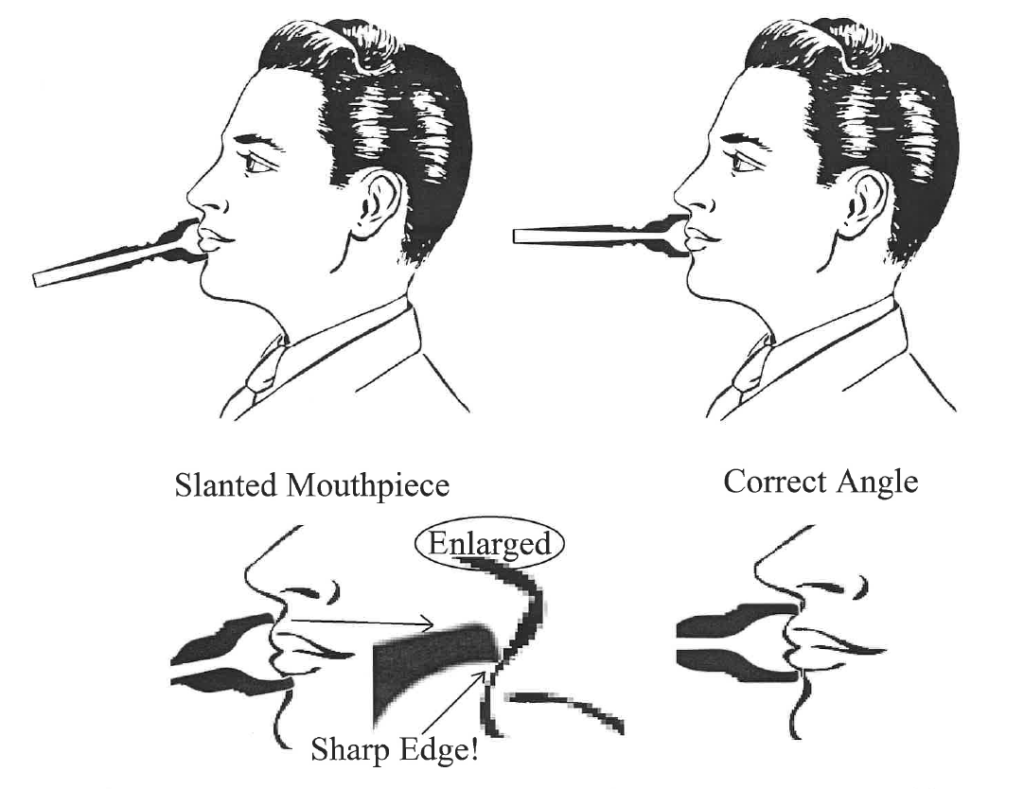
Excessive Mouthpiece Pressure
Pressure is both normal and required to isolate the tissue inside the mouthpiece from the tissue outside and to seal mouthpiece to lips
Increases with range, volume, and tiredness – how much pressure do you use? Are you talking about the beginning or the end of the concert
Pressure should be equal on both lips – both should be equally tired, often the top lip gets the brunt of the work – move the jaw forward to equalize the pressure, may need to adjust horn angle as well but must avoid slanted horn, which brings sharp edge of bite against the top lip, even if pressure is equal – Dr. Swift told me 5 times before it sunk in
Top lip is primary vibrator, lower lip must be free to be flexible – André mouthpiece
Excessive pressure = stiffness or soreness in the lip, cutting of the lip on the teeth or bruising (stuffy nose increases likelihood of split lip the next day)
We play by isometric tension; when we are too tired and cannot maintain our pucker (1930’s), we squash the lips between the teeth and the mouthpiece; can damage the lips: bruises, swelling, soreness, even cuts – the top lip swells more than the lower lip
have to heal before you can get stronger, so it slows progress; you may win the battle, but you’re losing the war
Results in reduced range, flexibility, endurance, and tone, play sharp
Bill Chase bent leadpipe in half on a high E; iced his lips daily while with Woody Hermann, or he couldn’t play the next day
Dr. Swift – if you’re going to press, you might as well stretch your lip on a table and hit it with a hammer and save the time; it’s like a long, drawn out punch to the mouth
Excessive pressure is not a problem – it is a symptom of a problem and/or lack of proper practice (proper air, firm corners in correct place)
Cut top of mouthpiece, inserted electronic pressure gauge, epoxied rim back – professionals used more pressure than amateurs (except Phillip Jones); cannot tell how much pressure is used by looking; how do pros handle more pressure? the firm embouchure protects the face – they are so strong that they can handle the abuse – like pro football players
Pressure tolerance varies between individuals
Moustache can also cause the player to use more pressure
Solutions
- Use leak and seal to establish correct corner position and a feeling of firmness in the corners, gives a way to fight back when you are tired; don’t go down with the ship – bail out the water!
- Corners must stay in the proper place using leak and seal; hard to do – cheek muscles are larger than the
orbicularis oris ; the chin muscles also factor in; it’s like arm wrestling with your leg – somehow we are able to make the corners stay put - Corners may be weak from a lack of practice or from improper practice — we are trying to build up lip muscles, not left arm muscles/corners should get tired before lips
- Reduce pressure 10% at a time until
acceptable level is met - Dr. Swift grip
- Gimmicks: push up thumb and forefinger at corners don’t let them move
- keep your corners firm or your false teeth will fall out
- Stop when you hit the point of decline – the two hardest things about practicing are starting and stopping
- Isometrics, pencil, pennies on lips; Brisbois – horn, trumpet, trombone, and tuba mouthpieces
- P.E.T.E. – Personal Embouchure Training Exerciser – Warburton – 2 exercises: lean over; pull away
Injuries: ice the lips with cold water to drive swelling out; never put ice on exposed flesh; can use heat to accelerate healing after swelling is gone; just like athletic injuries; the best thing is to avoid the injury!